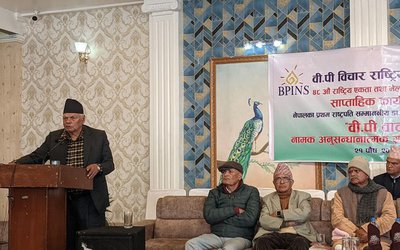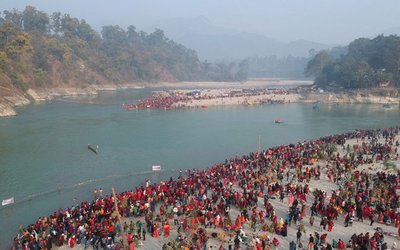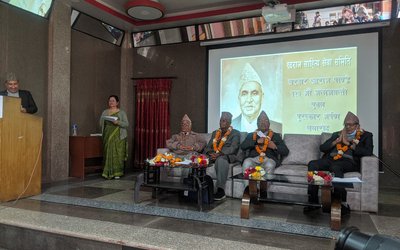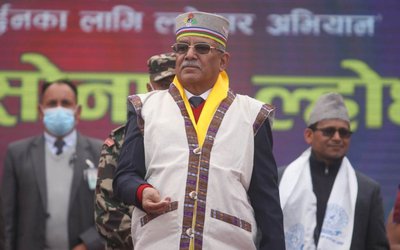
There are many books on the history of South Asia of the first millennium AD. One such book entitled The Early History of India by Vincent Arthur Smith is indeed special.
The book is one of his pioneering works on the Sakas, Kushans and Vakatakas, the early people of this region, and summarizes the available material on the ancient and early medieval periods. A British indologist and art historian, Smith also wrote about the Buddhist ruler Ashoka and Mughal emperor Akbar, trying to further portray a complete picture of the two great rulers who ruled ancient India. The book touches on Nepal when it deals with Chandragupta, who founded the Maurya empire, Emperor Asoka and King Harsha Vardhan – the three significant historical figures of the region.
According to V. A. Smith, Nepal has always maintained a close connection with India despite being outside the periphery of Indian politics. He stresses in his book that, “the kingdom of Nepal, the most valuable portion of which is the enclosed valley in which Kathmandu and other towns are situated, although it has remained generally outside the ordinary range of Indian politics, has maintained sufficient connection with India to require brief mention in a history of that country.” Smith claims that Nepal was an “integral part” of the Maurya empire, and was “probably administered directly from the capital as one of the home provinces.” He says, “in the days of [Gupt King] Samudragupta, in the fourth century AD, when we next hear of the Nepalese kingdom it was an autonomous tributary frontier state, but, after the fall of the Gupta empire in the following century, it became independent.”
The book shows that the birth of Gautama Buddha in Nepal in c. 563 BCE (or c. 480 BCE) was a significant turn in the history of the South Asian sub-continent. It covers the the history of the region from the century when Bouddha was born down to the first centuries after the Mohammedans entered India. Roughly speaking, this covers the period from 600 BC to 1200 AD.
Alexander the Great of Macedonia, who came to rule this region during 331–323 BC, is the next important figure after Bouddha. He is followed by three great rulers, Chandragupta, Asoka, and Harsha. They all had important consequences for Buddhism. The book deals with the dynasties before Alexander, his campaign in India and the subsequent advances towards expansion. Further, the history of Chandra Gupta Maurya (340 BC – 298 BC) and Bindusar, Asoka Maurya (299 BC -c. 237) and his successors, the Sunga, Kanva and Andhra dynasties, the dynasties of the Indo-Greek and Indo Parthian, and the Kushan or Indo-Scythian dynasties get significant coverage. The stories of the Gupta empire (320 to 550 CE) and the western satraps follow next. The white Huns, who remain obscure rulers in history, have also been described in the book. The reign of Harsha Vardhan, who ruled northern India during 606 to 647, the medieval kingdoms of the north, the kingdoms of the Deccan and the kingdoms of the south have been discussed in the last few chapters.
It is natural that Nepal finds its place as a frontier country when V. A. Smith deals with the history of the region. Nepal comes into the picture with the birth of Buddha in the Sakya territory, Kapilvastu, at the foot of the Nepali hills. The Sakya dedication of the relics of Buddha at Piprawa, which may date back to about 450 BC, and the number of inscriptions anterior to the Christian era are primary evidence of Bouddha’s birth there.He spent most of his monastic life in spiritual experiences at Bodh Gaya in Magadha. Sravasti was the capital of the neighbouring realm of Kosala, situated on the upper course of the Rapti river. Kapilvastu was captured by King Virudhaka of Kosala. Sakyas suffered much following this. At the time Buddha died, Ajatasatru was the ruler.He was the son of King Bimbisara of Magadh. Ajatsatru is also famous in the history for taking over the kingdom of Magadha from his father forcefully by imprisoning him. Records of the second and third centuries AD, however, are rare.
The book has no reference either about Kirants or Khasas when the author writes about Nepal. However, it is the assertion of V. A. Smith that “the triumphant progress of Alexander from the Himalaya to the sea demonstrated the inherent weakness of the greatest Asiatic armies when confronted with European skill and discipline. The dreaded elephants lost their terrors, and proved to be a poor defence against the Macedonian cavalry.” Alexander went on conquesting Panjab and Sind almost unopposed. However, Alexander 's premature death in Babylon at the age of 32 destroyed the fruits of his well-planned and successful capture of the South Asian sub-continent. His colonies here took no root. His campaign has been mentioned as a "successfully orchestrated raid on a gigantic scale" rather than a " permanent conquest".
In the year 249 BC, King Asoka of the Maurya dynasty, who was to be the mightiest warrior of all times, took over Magadh and occupied the throne for next twenty-three years. Asoka, a powerful Bouddhist, made a solemn pilgrimage to different places of Bouddhist importance including the famous Lumbini Garden, “the Bethlehem of Buddhism,” or the place where Bouddha was born. Saint Upagupta, his tour guide, addressed Asoka and said: " Here, great king! was the Venerable One born." This is where the famous Asokan pillar inscribed with these words still stands. He also took Asoka to Kapilavastu, “the home of Buddha's childhood.” He visited “Sarnath, near Benares, the scene of the Master's first success as a preacher; to Sravasti, where he lived for many years; to the Bodhi tree of Gaya, where he overcame the powers of darkness; and to Kusinagara, where he died.”
V. A. Smith states that the extent of the enormous empire governed by Asoka includes on the northwest the Hindu Kush mountains, Afghanistan, Baluchistan, and all of Sind, the secluded valleys of Suwat and Bajaur, and the valleys of Kashmir and Nepal. He built Srinagar as the capital of Kashmir. In terms of Nepal, V.A Smith provides references to the memorial visit of Asoka to Nepal in 250 B.C. He writes, “In the Nepal valley, he replaced the older capital, Manju Patan, by a city named Patan, Lalita Patan, or Lalitpur, which still exists.” Moreover, there are references to his daughter Charumati, who accompanied her father in his visit to Nepal and adopted a religious life in Nepal subsequent to her imperial father's return. V.A. Smith states, "She[Charumati] founded a town called Devapatana, in memory of her husband, Devapala Kshatriya, and settled down to the life of a nun at a convent built by her to the north of Pasupatinath, which bears her name to this day. Asoka treated Lalita Patan as a place of great sanctity, erecting in it five great stupas, one in the centre of the town, and four others outside the walls at the cardinal points.” All of these monuments still exist.
The pilgrimage of Asoka to Buddhist holy places, the erection of pillars at Lumbini Garden and a stupa of Kouakatnana, his visit to Nepal, and foundation of Lalita Patan, and his daughter Charumati becoming a Buddhist nun in Nepal are important historical references.
In the year 242 B. c., when his reign had lasted for thirty years, Asoka undertook a formal retrospect of all the measures adopted by him in furtherance of the ethical reforms which he had at heart, and took the opportunity of laying down a concise code of regulations concerning the slaughter and mutilation of animals, practices which he regarded with abhorrence.
During the reign of Harsha, the Hinduism revived again, though, more or less, the coxistence of both these religions remained as norm. “While toleration and concord were the rule,exceptions occurred. King Sasanka of Central Bengal, who has been mentioned as the treacherous murderer of Harsha's brother, hated Buddhism, “which he did his best to destroy. He dug up and burned the holy Bodhi tree at Bodh Gaya.” He also broke the stone marked with the footprints of Buddha at Pataliputra; and he destroyed the convents, and scattered the monks, carrying his persecutions to the foot of the Nepalese hills.” V. A. Smith guesses that these events must have happened about 600 AD. Harsha has been said to have reduced the Kingdom of Nepal to the position of a tributary state in around 638 AD.
Futhermore, an interesting reference demonstrating the the power and clout of Nepal at that time has been mentioned in the book. V.A Smith refers to the years 643-5 when the Chinese envoys led by Wang-Hiuen-tse to Harsha traveled through Tibet and Nepal. Before he reached Kannauj, in 648 AD, King Harsha had died, and there was instability and disorder in the kingdom. Wang-Hiuen-tse suffered much while the members of his escort were massacred. He was however fortunate enough to escape into Nepal by night. King Srong-tsan Gampo of Tibet, assisted the fugitives, and supplied them with a force of a thousand horsemen. This force cooperated with a Nepalese contingent of seven thousand men. With this force, Wang-hiuen-tse descended into the plains, and, after a three days’ siege, succeeded in storming the chief city of Tirhut. This followed the beheading of a thousand prisoners, the capturing of the entire royal family, taking twelve thousand prisoners, and obtaining thirty thousand head of cattle. Finally, Wang-hiuen-tse brought the usurper Arjuna as a prisoner to China, and was promoted for his services. Thus ended this strange episode, which, although known to antiquaries for many years, has hitherto escaped the notice of the historians of India.
V. A. Smith also mentions about King Raghava Deva who established the Nepalese era, which dates from October 20, 879 AD. Here he opines that some important event must have happened which needed to be marked in local history, but “the exact nature of which is not known.”
Smith notes an important difference between Nepal and the then India. In all vicissitudes of the sub-continent, the kingdom of Nepal was never subjugated by any of the Mohammedan dynasties while India was almost rampaged. The Palas and Senas at the neighbourhood of Nepal were “swept away by the torrent of Mohammedan invasion at the end of the twelfth century.” They were ruthless. In Bihar, “the slaughter of the ‘shaven-headed Brahmans,, that is to say, the Buddhist monks, was so thoroughly completed that, when the victor sought for some one capable of explaining the contents of the books in the libraries of the monasteries, not a living man could be found who was able to read them."
Describing the effect, the author says: “This crushing blow, followed up, of course, by similar acts of violence, destroyed the vitality of Buddhism in its ancient home. No doubt a few devout though disheartened adherents of the system lingered round the desecrated shrines for a few years longer, and even to this day traces of the religion once so proudly dominant may be discerned in the practices of obscure sects; but Buddhism as a popular religion in Bihar, its last abode in Upper India south of the Himalaya, was destroyed once and for all by the sword of a single Mussulman adventurer. Many monks who escaped death fled to Tibet, Nepal, and Southern India.” However, nowhere does the author mention that there was mass migration to Nepal hills.
V.A. Smith’s book is a single portal on the early history of the sub-continent from the Sixth Century B.C. to the Mohammedan Conquest. It makes for a wonderful reading.















